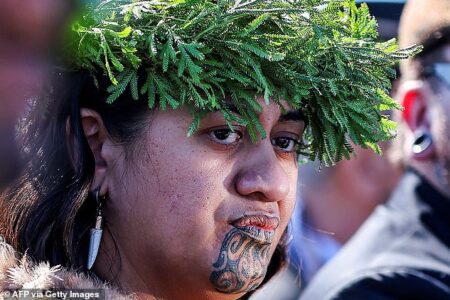Thousands have gathered for the funeral of Maori King Tuheitia, as his casket was guarded by warriors and paraded on a traditional canoe.
The mourners came to the North Island town of Ngāruawāhia on Thursday to pay final respects to New Zealand‘s Maori king, Kiingi Tuheitia Pōtatau Te Wherowhero VII, who died six days earlier.
The throne will now be passed on to his daughter, and witness the ascension to the throne of his daughter, Nga Wai Hono i te po Paki.
The new queen, 27, is the second woman to become a Maori monarch in a tradition dating back to 1858.
As she was escorted onto where her father’s casket lay draped in feathered cloaks, cheers rang out among thousands crowded around TV screens outside and waiting along the wide, flat banks of the Waikato River to glimpse the funeral procession.

The coffin with the body of New Zealand’s Maori King, Kiingi Tuheitia Pootatau Te Wherowhero VII

Maori King Tuheitia at Turangawaewae Marae meets with Britain’s Prince Charles in Ngaruawahia, south of Auckland, New Zealand November 8, 2015

The throne will now be passed on to his daughter, and witness the ascension to the throne of his daughter, Nga Wai Hono i te po Paki (pictured)
Kiingi Tuheitia’s successor and now Maori Queen Nga Wai hono i te po Paki looks on as Maori warriors paddle waka canoes down towards Taupiri Maunga
Maori warriors participate during the funeral ceremony of New Zealand’s Maori King
After her ascension, Nga Wai Hono i te po Paki accompanied the late king in a flotilla of traditional canoes along the river as he was guided by Maori warriors to his final resting place.
The events marked the end of a weeklong tangihanga – funeral rite – for Kiingi Tuheitia, 69, a leader who had in recent months rallied New Zealand’s Indigenous people to unity in the face of a more racially divisive political culture than before.
His daughter’s ascension represents the rise of a new generation of Maori leaders in New Zealand – one which grew up steeped in a resurging language that had once almost died out.
Kiingi Tuheitia died last Friday after undergoing heart surgery, just days after celebrations marking his 18th anniversary on the throne.
He became king after his mother’s death in 2006 and on Thursday was buried alongside her in an unmarked grave on Taupiri Maunga, a mountain of spiritual significance to his iwi, or tribe.
The Maori royalty movement is not a constitutional monarchy and King Charles III of Britain is New Zealand’s head of state.
It has a ceremonial mandate rather than a legal one and was formed in the years after British colonization of New Zealand to unite Maori tribes in resistance to forced sales of Indigenous land and the loss of the Maori language and culture.
Since 1858, the movement has championed Maori sovereignty, but monarchs have wielded politics lightly.
After a center-right government took power in New Zealand last November and began to enact policies reversing recognition of Maori language, people and customs, T*Tuheitia took the unusual step in January of calling a national meeting of tribes which was attended by 10,000 people.
A Maori warrior prepares a boat for the funeral ceremony
His daughter’s ascension represents the rise of a new generation of Maori leaders in New Zealand
The remains of Kiingi Tuheitia are placed on a waka on the Waikato river where he was to be carried by Maori warriors towards Taupiri Maunga during the tangi, or funeral rite
Maori warriors participate during the funeral ceremony of New Zealand’s Maori King
‘The best protest we can make right now is being Maori. Be who we are. Live our values. Speak our reo,’ he told them, using the Maori word for language. ‘Just be Maori. Be Maori all day, every day. We are here. We are strong.’
Tens of thousands of ordinary people also flocked there. Many spoke to each other in Maori, a language which had steadily waned after colonization until activists in the 1970s provoked its renaissance.
The late king, a truck driver before he took the throne, was a surprise appointment to the monarchy, which is chosen by a council and is not required to be hereditary.
But the new queen was groomed for the role and had accompanied her father in his work during recent years.
After the new queen was anointed with oils and a service for her father held, mourners flocked behind the hearse as it drove to the banks of the river sacred to his tribe.
Many had waited for hours to see the procession pass, including a large number of young families. Commentators said the queen’s ascension represented the culture’s renewal, with the majority of Maori – who account for almost 20% of New Zealand’s population – aged under 40.
Among them on Thursday was Awa Tukiri, 9, whose family had driven nearly two hours from Auckland to watch the canoe carrying the late king pass by.
‘It was pretty amazing because all they do on the boat is do haka and waiata on it,’ he said, using the words for Maori chants and songs. Tukiri, who attends a kura kaupapa – the immersion schools that are growing in popularity – said the best part of being Maori was ‘just hanging out and speaking Maori to each other.’


